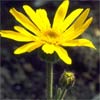 Arnica montana - Leopard's Bane Arnica montana - Leopard's Bane
Primary use: Trauma and bruising
Arnica is a remedy that no barn or stable should be without.
Use Arnica for the shock that accompanies injury or trauma. It is used primarily for muscle soreness and bruising due to blunt trauma but also can be useful as a first approach to overstrain. Arnica prevents the development of bruises and hemorrhages, hastens healing and can prevent septic infections from occurring after an injury. The horse who needs Arnica will feel sore, might become lame, and might also resist approach due to anticipation of pain. Arnica can help to calm the horse that is afraid to be touched or vetted after an injury.
Arnica should also be considered for any symptoms that develop post-injury. This is especially true if your horse seems fundamentally different in temperament after a trauma or injury. Head injuries are notorious for causing persistent symptoms long after the original injury appears to be healed.
General indications or modalities:
- Painful to the touch and fear or apprehension about being touched
- Horse has a hard time finding a comfortable position
- Worse with motion but better after continued motion
Conditions that respond to Arnica:
Bruising; shock; accidents/mechanical injuries; fear of touch and being approached; over-exertion/sprains; mental trauma or grief; high fever with hot head and cold body.
FOR THE RIDER: In the case of injury or serious fall, always give one dose of Arnica 1M as soon as possible.
Dosage: Give one dose. For severe acute conditions the remedy can be given every fifteen or twenty minutes. Stop when you see improvement and do not repeat again until symptoms recur.
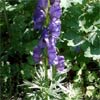 Aconite - Aconitum napellus - Monkshood Aconite - Aconitum napellus - Monkshood
Primary use: Fright, and sudden feverish illness especially after exposure to cold dry wind.
Aconite might be indicated in the first stages of a painful illness such as colic and it is especially useful in illnesses that come on after exposure to cold dry wind. Characteristically there is a sudden onset of symptoms. Conditions such as sudden lameness, fever or cold symptoms that come on suddenly or that closely follow a cold snap or wind-storm respond to Aconite. The horse might also be sweating and thirsty.
Aconite is a very important remedy for horses who panic or demonstrate terror. In an Aconite case the mental state of the horse is terror and this can be reflected in the physical symptoms such as rapid respiration, bounding pulse, shining or widened eyes, or trembling. (The guiding symptom in human homeopathy is the feeling that death is near.) Aconite is the first remedy to think of for fear and shock. If a horse is frightened by distressing situations think of Aconite. If your horse panics when asked to trailer-load, enter the show ring, or be clipped, Aconite might be of help, but only if the horse is truly terrified and not merely trying to avoid the situation. Aconite can help the frightened horse regain composure.
General indications or modalities:
- Worse from fright, shock or emotional trauma
- Horses that seem agitated long after a fright
- Worse from dry cold wind or exposure to cold
- Better from fresh air, rest. Can be better after sweating
Conditions that respond to Aconite:
Sudden ailments; violent and painful accidents; fear of death; restlessness, tossing, flushing and/or palpitation; acute inflammatory complaints; ailments from exposure to cold, dry wind or after shock or fear; fear of unknown and unfamiliar things; spookiness that persists after a frightening experience; the early stage of respiratory infections or the beginning of any febrile (feverish) condition. Older homeopaths that worked with animals before the advent of antibiotics often reported that one could prevent a serious infection by using Aconite at the very first hint of illness.
Dosage: Give one to three times daily at the first hint of illness or for fright or trauma. For severe acute conditions the remedy can be given every ten to fifteen minutes. Stop when you see improvement and do not repeat again until symptoms recur.
 Arsenicum album - White Arsenic Arsenicum album - White Arsenic
Primary Use: Gastrointestinal disorders such as ulcers or colic, especially when accompanied by anxiety and mental or physical restlessness.
The symptoms of pain in the GI tract, typically a burning sensation, are very close to the pain that horses with ulcers experience, and Arsenicum is a very useful remedy in the treatment of ulcers. Arsenicum is a remedy that corresponds to food poisoning. The type of colic that responds to Arsenicum may be brought on by eating contaminated or poor-quality feed as in “ moldy feed enteritis”. The colic often comes on suddenly.
The horse that needs Arsenicum might have a watery, foul-smelling diarrhea. Additionally, the stool might burn or break down the tissue around the anus. The smell is described as cadaverous—like a dead animal. The diarrhea can be dark or contain blood. The discharges associated with Arsenicum are putrid and excoriating—meaning they irritate the healthy tissue that comes in contact with the discharge. The horse might be thirsty but will only take frequent small amounts of water.
The horse that needs Arsenicum gets up and down and frequently changes positions. If the horse is in an advanced Arsenicum state he may be weak and down on the ground, but still making small movements of the limbs and head (the restlessness is so typical of this remedy). The abdomen might be drawn up. Arsenicum symptoms are generally worse from 11:00 PM to 3:00 AM. Horses that need Arsenicum can be very anxious and are calmed by the presence of people or other horses. They do not want to be alone. They are comforted by help and attention from others.
General indications or modalities:
- Worse from sight or smell of food
- Worse from around midnight to 3:00 am
- Worse from cold water, watery fruits; infections; exertion.
- Better from warm food or drink, warm blankets, warm stall
- Better from gentle walking, the company of humans or horses; lying with head raised.
Conditions that respond to Arsenicum:
Ulcers of the GI tract, especially in nervous horses; colic, particularly when brought on after eating contaminated food, intussusception of bowel; diarrhea, vomiting. In most cases of Arsenicum the horse will be restless, fearful, thirsty and chilly.
Dosage: Give one dose every three hours for diarrhea, pain and restlessness. For severe, acute conditions the remedy can be given every fifteen or twenty minutes. Stop when you see improvement and do not repeat again until symptoms recur.
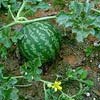 Colocynthus - Bitter Cucumber Colocynthus - Bitter Cucumber
Primary use: Colic with spasms
This is the first remedy to think of in a colicky horse with strong spasms that come and go in episodes. The pains might be quite violent with severe cramping. This pain makes the horse want to twist and look at or bite its flank. The horse might throw itself on the ground, hunch up or try to get into a position where it is able to double over, bending to compress its stomach. Compressing the abdomen brings some relief from the gassy distention. The horse’s abdomen will feel full, tight and distended. The Colocynthus colic makes the horse restlessly search for a position to alleviate the pain. He might try and lay down to roll, arch the back or he might gnash his teeth. The horse can be quite irritable with this kind of painful spastic colic and might prefer to be left alone.
General indications or modalities:
- Worse from cold, damp weather, drinking cold water after overheating
- Worse from eating and drinking
- Worse from anger and frustration, irritable
- Better from doubling over, pressure on the abdomen, lying on the stomach
- Better from heat and gentle motion after passing gas or manure
Conditions that respond to Colocynthus:
Colic with strong spasms; acute digestive affections; spasms of any muscle; neuralgic pain such as sciatica, especially on the left side
Dosage: Give one dose and repeat as frequently as every five minutes to reduce the extreme pain and spasms. As the horse is becoming more comfortable the doses can be spread out. Stop when you see notable improvement and do not repeat again until symptoms recur.
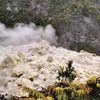 Hepar sulphuris Hepar sulphuris
Primary use: Abscessed wounds
This remedy is useful in the treatment of wounds that have become infected, either before or after pus has been produced. It helps abscesses to come to a head, drain and resolve. Think of using Hepar sulphuris for abscessed hooves or abscesses of the teeth, or in conditions such as Strangles.
With the intense pain of the abscess, the horse may become irritable and aggressive and very sensitive to touch. Horses needing Hepar sulphuris are usually very chilly. They might seek out the warmest spot in the stall or paddock.
General indications or modalities:
- The wound is painful to the touch
- The wound might be hot and might have pus
- The wound might bleed easily
- The horse is chilly and worse from the cold
Conditions that respond to Hepar sulphuris
Abscessed wounds, abscessed hooves, abscessed teeth; wounds that are contaminated with dirt.
Dosage: Give one dose every eight to ten hours to resolve an abscess or to bring it to a head and allow draining. Stop when you see improvement and do not repeat again until symptoms recur.
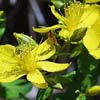 Hypericum – St. John’s Wort Hypericum – St. John’s Wort
Primary use: Nerve damage
Think of Hypericum in injuries in which nerves have been crushed, severed, or injured. In humans, Hypericum is the first remedy to remember when fingers or toes have been smashed or after injury to the coccyx (tailbone) after a fall. Mares with pelvic nerve damage after the birth of a large foal may benefit from Hypericum. Think of this remedy if your farrier has taken off too much hoof and your horse is sore. Hypericum might also relieve the pain of an abscessed tooth.
Surgery often involves cutting the nerves and Hypericum can be useful in decreasing the pain of an incision. Arnica might be the first remedy you think of after a surgery to decrease bruising and swelling but Hypericum can be used after the first 24 to 36 hours to reduce pain.
General indications or modalities:
- Worse from touch
- Worse after exposure to air (as in the removal of a bandage)
- Worse from cold
Conditions that respond to Hypericum
Damage to any nerve-rich area. Scrapes that leave raw, exposed or torn nerve endings. Road rash. Injury or breaks of the tail or injuries at the dock. Feet that are cut too short. Post-surgical pain.
Dosage: Give the remedy one to three times a day for 3 to 4 days until the symptoms begin to abate. For severe, acute conditions as in a nerve-crushing accident, the remedy can be given every fifteen or twenty minutes. Stop when you see improvement and do not repeat again until symptoms recur.
 Nux vomica Nux vomica
Primary use : Colic or indigestion from bad food or water or overeating in horses with an irritable temperament.
Horses that need Nux vomica have an irritable and sensitive temperament. They might be overly sensitive to noise, light and other stimulus. When in pain they are jumpy, angry, or they can be depressed and resentful and not want to be touched.
The type of colic that responds to Nux vomica is often brought on by overeating, or eating bad food or water. There might be strong spastic contractions, and urging without the ability to pass manure. The bowels might be blocked and strong spasms and straining are the result. In addition there might be intestinal rumbling and gurgling. The intestines can also be bloated. Constipation, nausea, retching, diarrhea and intussusception (the dangerous telescoping of the bowel) all are symptoms that might be helped by Nux vomica.
The horse that needs Nux vomica is often in a bad mood and is very sensitive to any kind of stimulus including touch, noise and light and strong odors. They often walk around slowly, are restless and might want to press their heads against the wall of their stall. Others might lie down and look repeatedly at the flank. Think of this remedy if there is restlessness, sensitivity, and indigestion. Another Nux vomica scenario might occur in show or performance horses that are given a diet of rich grains and then confined to a stall for long periods.
Nus vomica is also a good remedy for exposure to toxins, poisonous plants or drugs. Generally these exposures will result in the typical Nux vomica picture of spasms, sensitivity and irritability.
General indications or modalities:
- Indigestion or colic with strong spasms
- Constipation with straining
- Dull pain or violent pains
- Irritated and worse from touch. Worse at 3-4 am.
- The horse is chilly and might be better from heat or hot poultices
- Better from strong pressure Better after a nap.
Conditions that respond to Nux vomica
Indigestion from overeating or bad food or water;
impaction colic in horses; spasms of the gut with rumbling and gurgling; constipation or straining to make stool. Nux vomica also helps reverse negative effects from drugs or drug overdose. Can be useful after overexertion.
Dosage : Give one dose every 30 minutes or more frequently if symptoms are severe. Reduce dosage to one time a day. Stop when you see improvement and do not repeat again until symptoms recur.
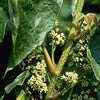 Rhus toxicodendron – Poison Ivy Rhus toxicodendron – Poison Ivy
Primary use: Joint inflammation with stiffness that is better after movement.
This remedy can be likened to a “rhusty” gate that is resistant to movement until someone opens and closes it a few times after which the motion is easier. With stiffness, lameness, or swelling of joints such as the knee, the horse will move poorly after rest and then improve to a point but will find its work very painful. It will become stiff and “gel” each time it rests. Horses that need this remedy are often restless but not out of impatience or anxiety—it is rather that they cannot find a comfortable position so they shift their weight constantly.
The modalities of Rhus toxicodendron are conditions that are much worse from cold, better from heat, and an indicator to the use of this remedy can be a horse that is always stiffer in the coolness of the morning or in cold damp weather.
This remedy might also be indicated in skin conditions where there is an itchy patch with tiny blisters—as in a case of poison oak. (Horses are generally immune to poison oak and often enjoy eating it.) Skin conditions that respond to Rhus toxicodendron have soft, fluid swelling or blisters and are worse from dampness and cold wetness, especially rain. These skin problems respond well to warm applications and, like other Rhus toxicodendron conditions, are better with motion.
General indications or modalities:
- Stiffness, especially after rest
- Better with movement, as in inflammation or lameness that goes away after the warm-up
- Better in warm dry weather
- Worse in cold wet weather
Conditions that respond to Rhus Toxicodendron:
Arthritis, joint inflammation and swelling, stiffness relieved by motion. Skin eruptions with little blisters.
Dosage : This remedy works best when given in the morning. Give one dose every morning until improvement is noted. Stop when you see definite improvement and do not repeat again until symptoms recur.
 Ruta graveolens – Meadow Rue Ruta graveolens – Meadow Rue
Primary use: Ligamentous or tendon strains
The horse can have pain while standing and stretching or lying down but this becomes even worse with movement. Useful in treating splint and ringbone.
General indications or modalities:
- Pain in the soft tissues of the extremities such as ligaments and tendons
- Sprains and strains that are better from some motion, but worse from real work
- Worse from cold wet weather
- Worse from lying down
Conditions that respond to Ruta graveolens:
Ligamentous sprains, bowed tendons, splints, ringbone, damage to the periosteum of bone, avulsions where the ligamentous attachment to the bone is torn, bruised bones after being kicked; Splints and ringbone; pain in the sacroiliac area; lameness after sprains, especially of the fetlocks, knees, hocks, and stifles.
Dosage: Give one dose one to three times a day after ligamentous injury; continue for 3 days. Because ligaments are slow to heal the remedy can be repeated twice a week for 1 to 3 weeks. Stop when you see improvement and do not repeat again until symptoms recur.
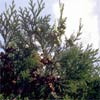 Thuja occidentalis – Arborvitae, Tree of Life Thuja occidentalis – Arborvitae, Tree of Life
Primary use: The ill effects of vaccination; warts
Thuja (pronounced thu-ya) is traditionally considered the remedy to turn to for all instances of negative effects after vaccines (a condition called vaccinosis). Signs of vaccinosis can include large, hard lumps that remain days after the vaccination; warts, sarcoids, general fatigue or lack of health that comes on after vaccinations. This might include the sudden appearance of allergies and skin eruptions following immunizations. Many holistic veterinarians recommend that Thuja be given concurrently with any vaccination but it probably is better to handle each horse as an individual and give the remedy if any signs of vaccinosis occur.
One characteristic that is an indication for Thuja is overgrowth of tissue, thus Thuja is an important remedy for the treatment of warts. The warts have a rough cauliflower-like surface and might bleed or give off a foul-smelling discharge. The warts of Thuja can appear anywhere but are often found either on the muzzle or around the genitals. The horse can be particularly affected in the scrotum and sheath area by warts.
Thuja has been found to be useful in the treatment of neglected, chronic cases of hoof degeneration. The hoof can appear to be curling upwards at the toes. Because Thuja is useful in treating tissue overgrowth, it might be very helpful in preventing proud flesh or the granulation tissue overgrowth that can follow an injury.
Many skin conditions including rain rot or rain scald and Scratches respond favorably to Thuja.
General indications or modalities:
- Worse from cold damp air
- Worse from being vaccinated
- Better lying on the left side. Symptoms can be worse on the left side
Conditions that respond to Thuja:
Bad effects from vaccinations; Warts, Rain rot
Thuja is useful for bleeding fungal growths; anal warts, sarcoids, spongy tumors, glandular enlargement. The genito-urinary system responds well to this remedy including ailments with thick, yellow-green discharges; increased sexual urges. Other conditions include hair that grows slowly and splits, or after re-vaccination when the hair is very dry and possibly falling out.
Dosage:
Give with vaccinations to sensitive horses; one dose. Give once a day for five days if vaccinosis occurs. Treat daily for one week for most cases of warts. For rain rot: daily for five days and repeat if symptoms recur.
|